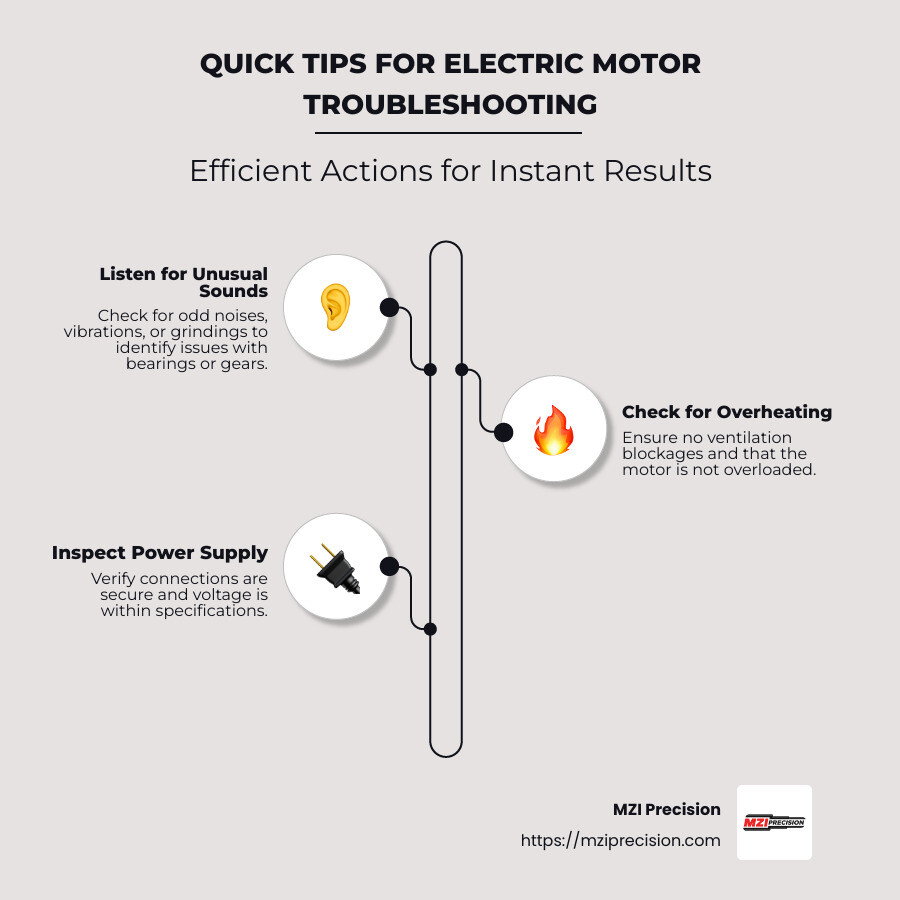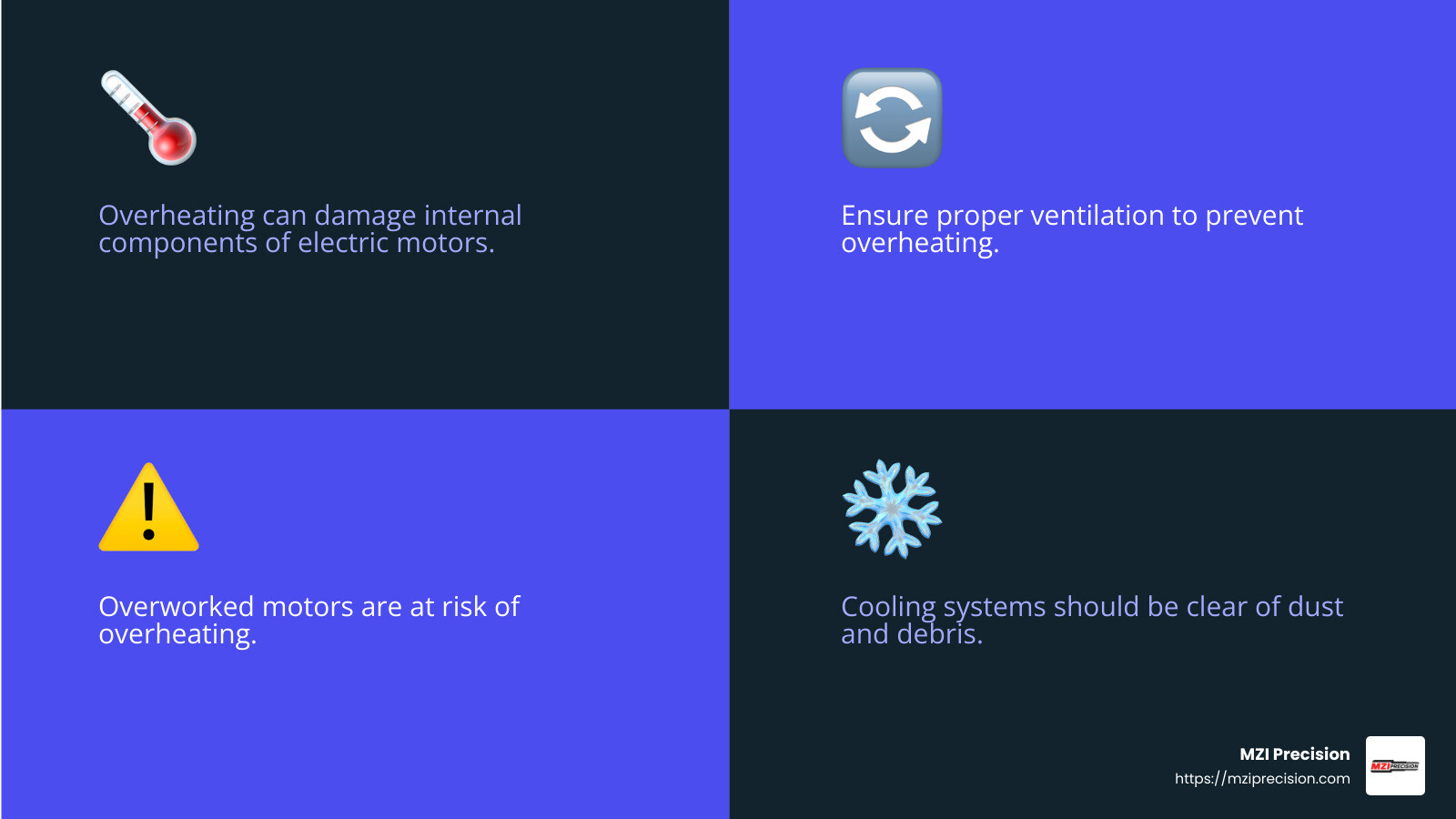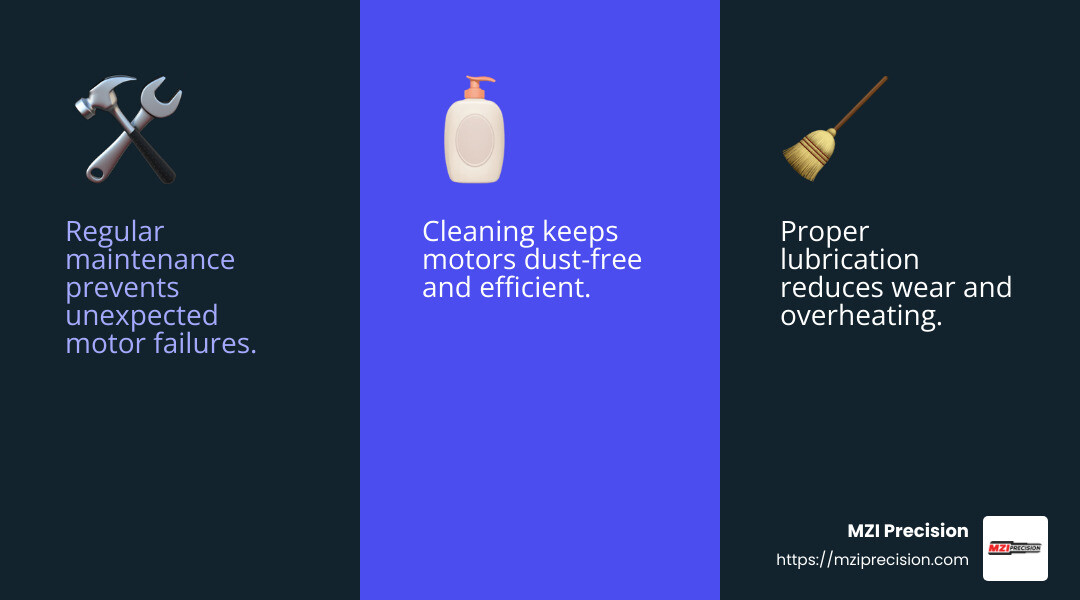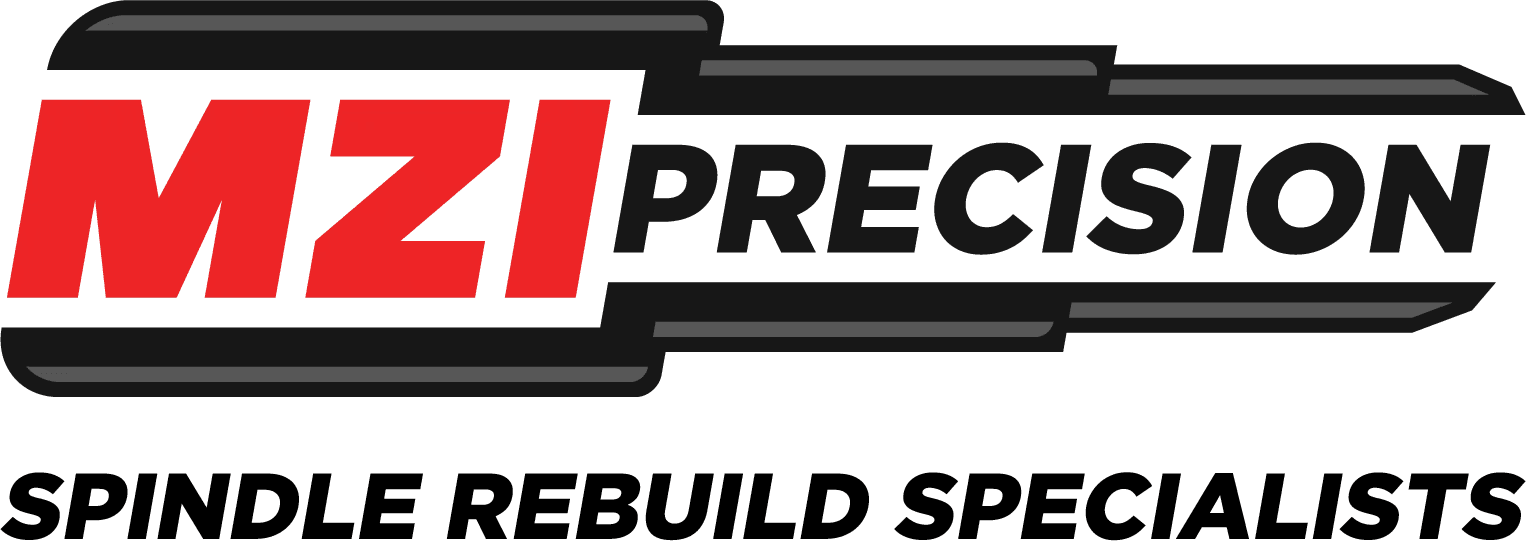Electrical motor troubleshooting is crucial when industrial manufacturing spindles are at the heart of your operations. From aerospace to heavy manufacturing, a spindle motor issue can disrupt productivity and drive up costs. If you’re short on time, here’s a quick list of troubleshooting actions you might find useful:
- Listen for unusual sounds or vibrations. This could signal underlying issues with bearings or gears.
- Check for overheating. Liftd temperatures often indicate ventilation problems or overload.
- Inspect power supply. Ensure connections are secure and the voltage is within manufacturer specifications.
Efficient troubleshooting saves both time and money, reducing downtime and ensuring smooth operations. By focusing on these critical aspects, you can often diagnose and address potential issues before they escalate.

We will explore how you can effectively diagnose and troubleshoot common electric motor and spindle issues. Understanding these basics not only helps in quick fixes but also aids in preventive maintenance. Stay tuned to learn more about keeping your industrial machinery in peak condition.
Common Causes of Electric Motor Failure
Electric motors are the backbone of industrial manufacturing spindles. But like any machine, they can fail. Understanding the common causes of failure is key to preventing downtime and costly repairs. Let’s explore the top reasons why electric motors break down.
Overheating
Overheating is a frequent issue with electric motors. It occurs when the motor runs hotter than it should, damaging its internal components. This can happen if the motor is overworked, lacks proper ventilation, or is operating in a high-temperature environment.
Solution:
– Turn off and cool down: If a motor overheats, shut it down immediately and let it cool.
– Check ventilation: Ensure that the cooling system is clear of dust and debris.
– Monitor capacity: Make sure the motor isn’t working beyond its capacity.

Electrical Overload
Electrical overload occurs when the motor draws more current than it’s designed to handle, often leading to overheating. This can be caused by incorrect voltage supply, short circuits, or excessive load.
Solution:
– Shut down and inspect: Stop the motor to prevent further damage.
– Check power supply: Ensure the voltage and load are within the motor’s specifications.
– Adjust load: Reduce the motor’s load or use a motor with a higher capacity if needed.
Contamination
Contamination involves dirt, dust, or other foreign materials entering the motor, causing wear and tear. This is common in dirty environments or when motors are not properly sealed.
Solution:
– Clean the motor: Thoroughly remove any foreign materials from the motor.
– Inspect seals: Check and replace any damaged seals or covers.
– Use suitable motors: In dirty environments, consider using motors designed for such conditions.
Vibration
Vibration is excessive shaking or movement that can harm a motor over time. This can be due to improper mounting, imbalance, or worn-out parts, leading to misalignment and component loosening.
Solution:
– Secure mounting: Ensure the motor is firmly attached to its base.
– Balance the motor: Adjust weights or balance the motor to correct any imbalances.
– Replace worn parts: Identify and replace any components causing vibration.
Improper Lubrication
Lubrication is crucial for smooth motor operation. Improper lubrication, whether too much or too little, can cause friction and wear. Using the wrong type of lubricant can also lead to problems.
Solution:
– Check lubrication levels: Ensure the motor has the right amount of lubricant.
– Use correct lubricant: Follow the manufacturer’s recommendations for lubricant type.
– Maintain regularly: Regularly check and maintain lubrication levels to prevent issues.
Understanding these common causes of electric motor failure can significantly reduce the risk of breakdowns. By taking proactive steps, you can keep your industrial manufacturing spindles running smoothly and efficiently.
Electrical Motor Troubleshooting Techniques
When it comes to electrical motor troubleshooting, having a systematic approach can save both time and money. Let’s explore some key techniques that will help you diagnose and resolve common issues effectively.
General Inspection
Start with a general inspection. Look for visible signs of damage like burnt wires, loose connections, or worn-out components. Check the motor’s environment for dust or debris that might have accumulated. This initial step can often reveal obvious problems and prevent further complications.
Power Supply Test
A power supply test is crucial to ensure the motor is receiving the correct voltage. Use a multimeter to measure the voltage at the motor terminals. Make sure the readings match the motor’s specifications. If the voltage is too high or too low, it could lead to performance issues or even damage the motor.
Insulation Resistance Test
Conducting an insulation resistance test helps identify any breakdowns in the motor’s insulation. Use a Megger or insulation tester to measure the resistance between the motor windings and the ground. Low resistance indicates potential insulation failure, which can cause short circuits and other serious problems.
Running Amps Test
Finally, perform a running amps test to check the motor’s current draw under normal operating conditions. Compare the measured amps with the motor’s rated current. If the motor is drawing more current than it should, this could indicate an overload, faulty windings, or mechanical issues.
By using these techniques, you can systematically identify and address issues, ensuring that your industrial manufacturing spindles operate reliably and efficiently.
Diagnosing and Solving Overheating Issues
Overheating in electric motors, especially in industrial manufacturing spindles, can lead to serious damage and costly downtimes. Understanding the root causes of overheating is crucial for effective troubleshooting and maintenance. Let’s break down the common factors contributing to overheating and how to address them.
High Temperatures
High operating temperatures are a leading cause of motor failure. When a motor runs too hot, it can degrade insulation, damage bearings, and lead to premature failure. Regularly monitor the motor’s temperature using thermal sensors or infrared cameras to ensure it stays within safe operating limits.
Blocked Cooling System
A blocked cooling system can drastically increase the motor’s temperature. Dirt, dust, and debris can clog air vents and cooling fans, reducing airflow and heat dissipation. Routine cleaning of the cooling system and ensuring all vents are unobstructed can prevent this issue. In some cases, installing additional cooling fans or heat exchangers might be necessary to maintain optimal temperatures.
Ambient Temperature
The environment where the motor operates plays a significant role in its thermal management. High ambient temperatures can exacerbate overheating problems. Ensure that the motor is installed in a well-ventilated area and away from external heat sources. If the ambient temperature is consistently high, consider improved cooling solutions or relocating the motor to a cooler environment.
By addressing these factors, you can significantly reduce the risk of overheating in your industrial manufacturing spindles, ensuring they run smoothly and efficiently. Regular maintenance and proactive monitoring are key to preventing overheating and extending the lifespan of your electric motors.
Addressing Electrical Overload and Power Supply Problems
Electrical overload and power supply issues are common challenges in maintaining industrial manufacturing spindles. These problems can lead to motor failure, decreased performance, and costly downtime. Let’s explore how to effectively troubleshoot and resolve these issues.
Voltage Spikes
Voltage spikes are sudden increases in electrical voltage that can damage motor components. They often result from lightning strikes, switching operations, or faults in the power grid. To protect your motors from voltage spikes, consider installing surge protectors or voltage regulators. These devices can help stabilize the voltage and prevent spikes from reaching critical motor parts.
Short Circuits
Short circuits occur when there is an unintended connection between two points in the electrical system, causing excessive current flow. This can lead to overheating and damage to the motor windings. Regular inspection of electrical connections and using circuit breakers can help detect and isolate short circuits, minimizing their impact on your motor system.
Phase Imbalance
In three-phase power systems, phase imbalance happens when the voltage or current is not equal across all phases. This can cause excessive heating and vibration, leading to motor failure. To address phase imbalance, regularly monitor the current and voltage across each phase. If an imbalance is detected, check for loose connections, faulty wiring, or load distribution issues.
Power Quality Analyzer
A power quality analyzer is an essential tool for diagnosing power supply problems. It measures parameters such as voltage, current, frequency, and harmonics, providing a comprehensive view of the power quality. By using a power quality analyzer, you can identify issues like voltage sags, swells, and harmonic distortions that may affect motor performance. With this data, you can implement corrective measures to improve power quality and ensure optimal motor operation.
Addressing these electrical overload and power supply problems requires vigilance and the right tools. By keeping a close eye on voltage stability, inspecting for shorts, monitoring phase balance, and utilizing a power quality analyzer, you can maintain the reliability and efficiency of your industrial manufacturing spindles.
Regular maintenance and proactive troubleshooting are key to preventing these issues and ensuring the longevity of your electric motors. Understanding these challenges and how to address them will help keep your operations running smoothly and efficiently.
Importance of Regular Maintenance and Inspection
Regular maintenance and inspection are critical for the longevity and performance of industrial manufacturing spindles. Neglecting these essential tasks can lead to poor motor performance, unexpected failures, and costly repairs. Let’s explore the key aspects of maintenance that can keep your motors running smoothly.
Poor Maintenance: A Costly Oversight
Ignoring regular maintenance can have serious consequences. Motors can overheat, wear out, or fail due to lack of attention. Consistent checks and services help identify small issues before they become big problems. Regular maintenance includes cleaning, lubrication, and alignment, which are all essential to motor health.
Lubrication: The Lifeline of Moving Parts
Proper lubrication reduces friction and wear on moving parts. Without it, motors can overheat and seize up. Follow the manufacturer’s guidelines for lubrication intervals and types of lubricants. This simple step can significantly extend the life of your spindle.
Alignment: Keeping Things Straight
Misalignment in motors can cause excessive vibration and noise. It can lead to premature wear and even failure. Use alignment tools to ensure the motor and driven equipment are perfectly aligned. Regular alignment checks can save time and money in the long run.
Cleaning: Keeping It Dust-Free
Dust and debris can cause motors to overheat and malfunction. Regular cleaning prevents dirt from accumulating and affecting the motor’s performance. Use a clean, dry cloth to wipe down surfaces, and compressed air to blow out hard-to-reach areas. This simple habit can prevent many common motor issues.

Implementing a regular maintenance schedule and sticking to it is vital. By focusing on lubrication, alignment, and cleaning, you can prevent many common issues that lead to motor failure. This proactive approach not only extends the life of your industrial manufacturing spindles but also ensures they operate at peak efficiency.
Frequently Asked Questions about Electrical Motor Troubleshooting
What are the three most common electrical problems in an electric motor?
Electric motors can face several issues, but three problems are particularly common:
-
High Temperatures: Overheating is a major issue. It can occur when motors run for long periods, lack proper ventilation, or operate above their capacity. High ambient temperatures can worsen the problem, leading to damage of internal components.
-
Dust Accumulation: Dirt and dust can enter the motor and cause contamination. This affects its efficiency and can lead to wear and tear. Keeping the motor clean is crucial to prevent overheating and ensure smooth operation.
-
Power Surges: Sudden spikes in voltage can damage motors. Power surges might result from lightning strikes or other high transient voltages. Installing surge protectors can help prevent this kind of damage.
How do you diagnose an electric motor problem?
Diagnosing electric motor issues involves a few key steps:
-
General Inspection: Start with a visual check for any obvious signs of wear, damage, or contamination. Look for broken parts, darkened paint indicating overheating, or debris around the motor.
-
Use a Multimeter: This tool helps check the electrical aspects of the motor. You can measure voltage, current, and resistance to identify electrical faults such as short circuits or open circuits.
-
Megger Testing: A Megger or insulation resistance tester can be used to check the condition of the motor’s insulation. This test helps identify if the insulation is breaking down, which is a common cause of motor failure.
What is the most common cause of electric motor failure?
The most common cause of electric motor failure is winding insulation breakdown. Over time, the insulation that protects the motor’s windings can degrade due to heat, contamination, and electrical stress. This breakdown can lead to short circuits and ultimately motor failure. Regular maintenance, including checking insulation resistance and ensuring proper cooling, can help prevent this issue.
Another frequent problem is bearing wear. Bearings support the motor’s rotating parts, and their failure can lead to excessive vibration and noise. Regular lubrication and inspection can help keep bearings in good condition and prevent premature wear.
Conclusion
At MZI Precision, we understand the critical role that industrial manufacturing spindles play in your operations. These components are the heartbeat of many industrial processes, and their proper functioning is essential for maintaining productivity and efficiency.
Our commitment to exceptional service is evident in every spindle we repair or rebuild. We bring years of expertise and a deep understanding of OEMs to every project, ensuring that our solutions are not just quick fixes but long-term investments in your equipment’s reliability and performance.
Why choose MZI Precision for your industrial manufacturing spindle repair needs? Here are a few reasons:
-
Expert Knowledge: Our team is skilled in diagnosing complex issues and providing precise solutions. We go beyond surface-level fixes to address the root causes of spindle malfunctions.
-
Advanced Facilities: We use state-of-the-art equipment and techniques to ensure that each spindle is returned to you in prime condition, ready to meet the demands of precision machining.
-
Customer Satisfaction: Our unwavering commitment to customer satisfaction drives us to deliver unparalleled service and support. We pride ourselves on our attention to detail and our ability to exceed customer expectations.
-
Timely Interventions: We understand the importance of minimizing downtime. Our efficient processes and quick turnaround times ensure that your operations continue smoothly with minimal interruption.
By choosing MZI Precision, you are not just solving an immediate problem; you are partnering with a team dedicated to enhancing the longevity and efficiency of your machinery.
For more information on our services and how we can assist with your electric motor and spindle repair needs, visit our Electric Motor Repair page. Let us help you keep your equipment running at its best.



